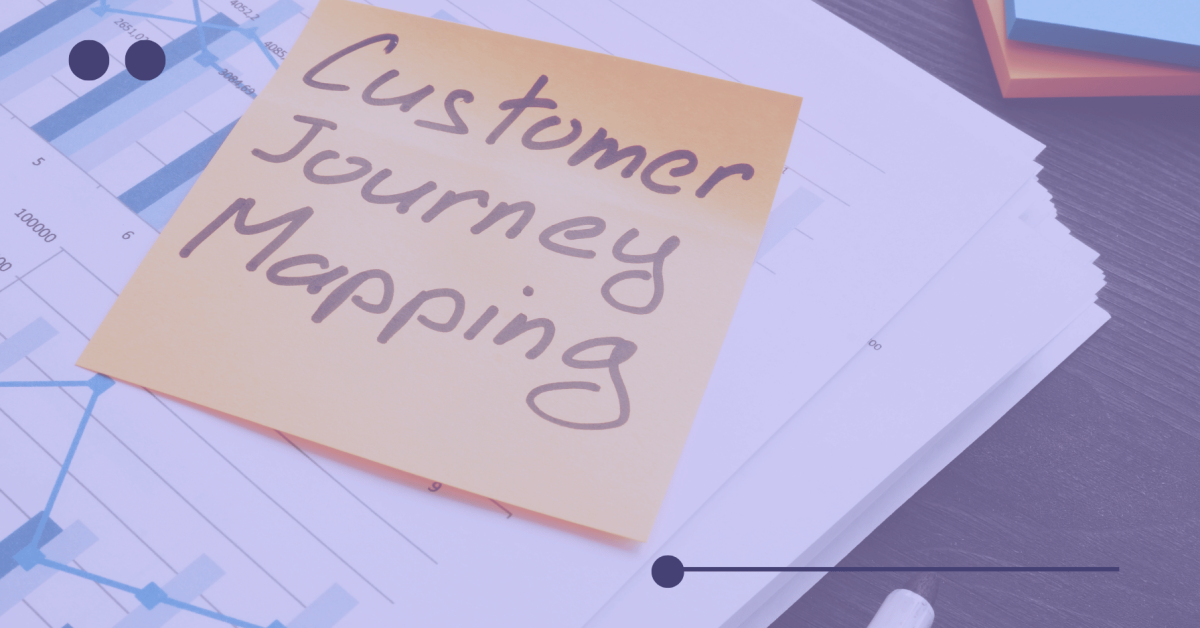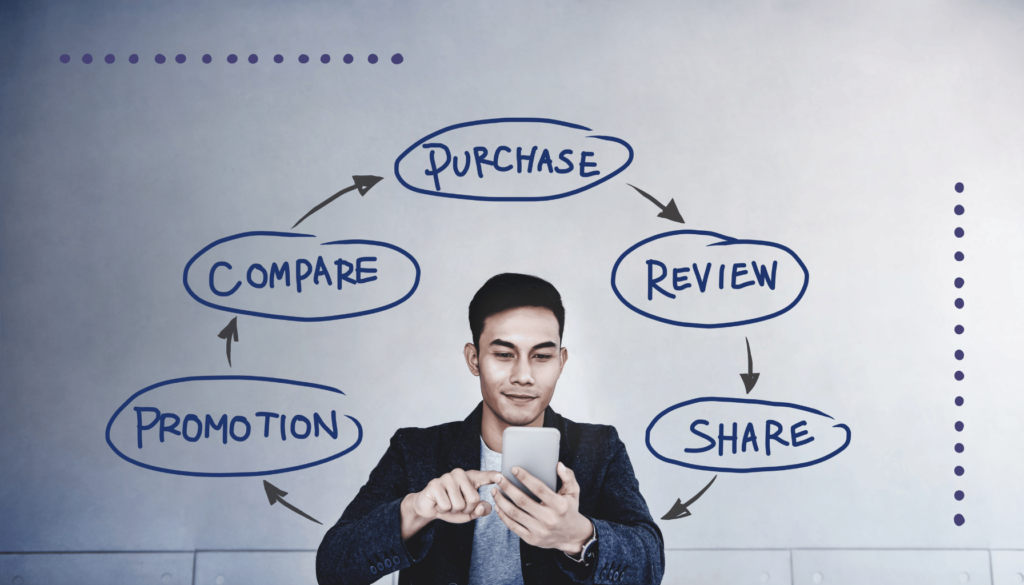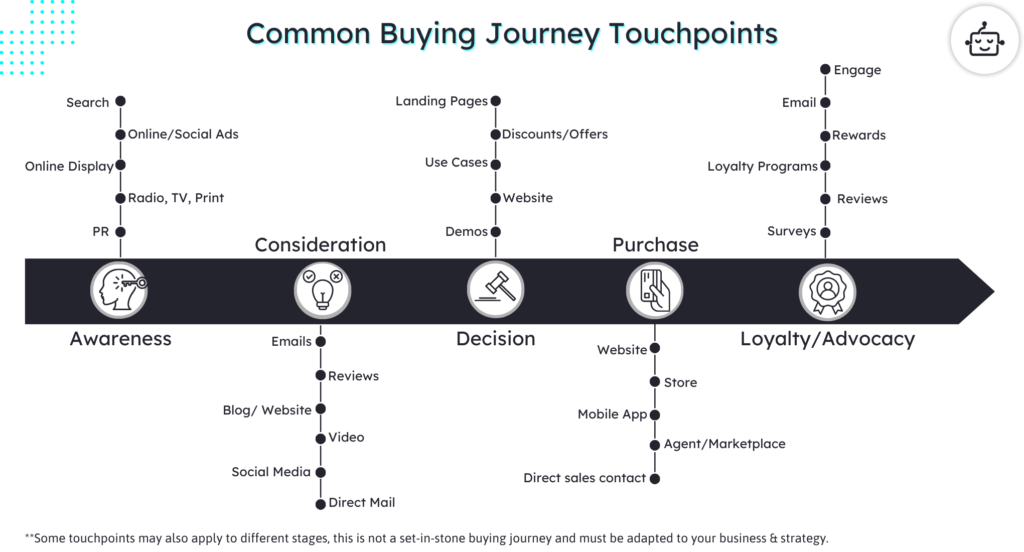
The process of mapping your B2B customer journey plays a pivotal role in unlocking increased sales. By understanding and visualizing the steps and interactions involved in a business buyer’s purchase decision, you can gain crucial insights into buyer behavior and preferences. This will enable you to align your marketing and sales efforts effectively, create targeted content, and optimize your strategies for maximum impact.
Let’s explore the importance of B2B buyer journey mapping and how it can help you drive sales growth and enhance customer satisfaction.
Understanding the B2B Buyer Journey
Stage 1: Awareness
The awareness stage marks the beginning of the B2B buyer journey, where businesses recognize and become conscious of their pain points and challenges. This stage involves a detailed analysis of internal processes, operations, and market dynamics to identify areas that require improvement or optimization.
The awareness stage in the B2B buyer journey is a critical starting point, as it sets the course for businesses to address their challenges effectively. By investing time and effort into understanding their pain points and researching potential solutions, you can make informed decisions that lead to improved operational efficiency, cost savings, and enhanced competitiveness in the market.
Understand your customer journey analytics
See how your users behave, find drop-offs, and receive actionable insights with AI.

Let’s consider an example of a software-as-a-service (SaaS) company that specializes in customer relationship management (CRM) solutions.
Identifying pain points and challenges:
- Example: The SaaS company realizes that its current CRM system lacks advanced automation features, resulting in manual and time-consuming processes.
- They’re conducting internal assessments, including interviews with sales, marketing, and customer support teams to understand their pain points and limitations.
- And analyzing customer feedback, churn rates, and performance metrics to identify areas that require improvement.
Researching potential solutions:
- The SaaS company begins researching CRM software providers that offer robust automation capabilities, integration options, and scalability.
- They explore industry-specific resources, such as technology blogs, analyst reports, and software review platforms, to gain insights into market trends and leading CRM solutions.
- And leverage professional networks, attend technology conferences, and engage with industry experts to learn about innovative CRM offerings.
During the awareness stage, businesses aim to gain a clear understanding of their pain points and challenges. By identifying areas that require improvement, they can set the foundation for seeking suitable solutions. It is crucial for businesses to involve key stakeholders, such as executives, managers, and department heads, in this process to gather diverse perspectives and ensure a comprehensive assessment.
Researching potential solutions enables businesses to explore various options available in the market. They can evaluate different vendors, technologies, and approaches that align with their specific needs and objectives. The goal is to gather relevant information and insights that will guide decision-making in the subsequent stages of the buyer journey.
Stage 2: Consideration
In the B2B buyer journey, the consideration stage is a critical phase where businesses evaluate different vendors and options to address their identified pain points. Let’s continue with the example of the SaaS company specializing in CRM solutions.
Evaluating different vendors and options:
- The SaaS company compiles a list of CRM software providers known for their automation capabilities, scalability, and integration options.
- They conduct in-depth research on each vendor, examining their reputation, industry presence, and customer reviews.
- While seeking referrals from industry peers or trusted advisors who have experience with CRM implementations.
Comparing features, benefits, and pricing:
- The SaaS company compares the features, benefits, and pricing models offered by the shortlisted CRM vendors.
- They evaluate the automation capabilities, customization options, and user interface of each CRM solution.
- And analyze the benefits that each vendor’s CRM software can provide, such as improved sales efficiency, enhanced customer insights, and streamlined workflows.
During the consideration stage, companies aim to make an informed decision by carefully evaluating different providers. They assess factors such as functionality, ease of use, scalability, and vendor reputation to ensure the chosen solution aligns with their business requirements.
By evaluating different vendors and options, the SaaS company gains insights into the strengths and weaknesses of each CRM solution. They consider factors like integration capabilities with existing systems, data security measures, and the availability of ongoing support and training. Additionally, they carefully examine the pricing models, subscription plans, and any additional costs associated with implementation and customization.

Stage 3: Decision
The decision stage is a crucial phase in the B2B buyer journey, where businesses finalize their selection and proceed with negotiations, procurement processes, and contract agreements. Let’s continue with our example.
Negotiations and procurement processes:
- The SaaS company engages in negotiations with the chosen CRM vendor to discuss pricing, contract terms, and implementation timelines.
- They address specific requirements and customization needs to ensure the CRM solution aligns with their business processes.
- And collaborate with procurement teams to navigate the necessary approvals, legal considerations, and vendor selection criteria.
Contract agreements and final selection:
- After negotiations, the SaaS company finalizes the contract agreement with the CRM vendor that best meets their needs.
- They review contract terms and conditions, ensuring they align with the agreed-upon pricing, service-level agreements, and data security provisions.
- And confirm the selection of the CRM vendor and obtain the necessary sign-offs from key stakeholders.
During the decision stage, companies normally work closely with the chosen vendor to solidify the partnership. Negotiations focus on achieving mutually beneficial terms and addressing any unique requirements or customizations needed for successful implementation.
The procurement processes involve coordination with internal stakeholders, such as legal teams, finance departments, and IT personnel. They ensure compliance with internal policies and procedures while navigating the necessary steps to finalize the vendor selection and move forward with the implementation phase.
By diligently going through the decision stage, businesses ensure that the vendor selected not only meets their technical and operational requirements but also aligns with their strategic goals and long-term vision. This stage sets the foundation for successful implementation and paves the way for productive and mutually beneficial partnerships.
Stage 4: Post-Purchase
The post-purchase stage of the B2B buyer journey is where businesses assess the value and effectiveness of the solution they have implemented. It involves evaluating the outcomes, providing feedback, and engaging in ongoing customer support.
Assessing the value and effectiveness of the solution:
- The SaaS company measures key performance indicators (KPIs) to evaluate the impact of the CRM solution on their sales, customer retention, and operational efficiency.
- They will analyze data and metrics to determine if the CRM solution has improved productivity, streamlined processes, and enhanced customer relationships.
- And conduct regular reviews and comparisons against pre-implementation benchmarks to track progress and identify areas for further improvement.
Providing feedback and engaging in customer support:
- The SaaS company actively communicates with the CRM vendor, providing feedback on the solution’s performance, usability, and any identified areas for enhancement.
- The company will engage in ongoing discussions with the vendor’s customer support team to address any technical issues, seek guidance, and explore additional features or integrations.
- And they will participate in user forums, attend webinars, or provide testimonials to share their experience and contribute to the CRM vendor’s community.
During the post-purchase stage, the SaaS company of our example focuses on evaluating the effectiveness of the CRM solution in achieving its intended goals. They leverage data and analytics to gain insights into the impact the solution has had on their business operations and overall performance. This assessment enables them to make data-driven decisions and identify areas where further optimization may be required.
In addition to assessment, the company actively engages in providing feedback to the CRM vendor. This feedback loop helps the vendor understand their customers’ experiences and enables them to continually enhance the solution’s features, user experience, and overall value proposition. The company also benefits from ongoing customer support, addressing any technical issues, receiving guidance, and exploring additional functionalities that can further enhance its CRM implementation.
By actively participating in the post-purchase stage, the companies ensure they are maximizing the value derived from the chosen solution. They foster a collaborative relationship with the vendor, contributing to product improvement while benefiting from ongoing support and staying updated on new features or enhancements. This continuous evaluation and engagement help the companies achieve long-term success.
Steps to Conduct Effective B2B Buyer Journey Mapping
1. Gathering Research and Data
To conduct effective B2B buyer journey mapping, it’s essential to gather research and data that provide insights into the customers’ purchasing behavior and decision-making process.
By effectively gathering research and data through interviews, surveys, customer feedback, and behavior analysis, you can gain comprehensive insights into the B2B buyer journey. These insights serve as the foundation for developing accurate buyer personas, identifying pain points, and designing targeted marketing strategies.
Ultimately, this data-driven approach will enable you to optimize your customer experience and drive better results throughout the buyer journey.
Conducting interviews and surveys:
- Engage with existing customers, prospects, and key stakeholders to gather qualitative insights through interviews.
- Create surveys that capture relevant data, including pain points, challenges, preferences, and factors influencing the decision-making process.
- Leverage customer relationship management (CRM) systems and marketing automation tools to streamline data collection and analysis.
By conducting interviews and surveys, you can directly engage with your target audience to understand their needs, motivations, and pain points. This qualitative data provides valuable insights into customer perspectives, helping shape effective marketing strategies and improve the overall buyer experience.
Analyzing customer feedback and behavior:
- Utilize Pathmonk Intelligence to track and analyze customer behavior on digital platforms, including website interactions, click-through rates, and conversion data.
- Combine qualitative and quantitative data to identify patterns, trends, and areas for improvement in the buyer journey.
Understand your customer journey analytics
See how your users behave, find drop-offs, and receive actionable insights with AI.

Analyzing customer feedback and behavior will provide you with a deeper understanding of how customers engage with your brand throughout the buyer journey. It helps identify pain points, areas of friction, and opportunities to enhance the customer experience. By tracking customer behavior, you can optimize touchpoints, content, and marketing campaigns to align with customer preferences and drive better results.

2. Creating Buyer Personas
Buyer personas are fictional representations of ideal customers that help you better understand your target audience and tailor your marketing efforts.
Creating accurate buyer personas will help you develop targeted marketing strategies, personalized messaging, and relevant content that resonates with your ideal customers. These personas serve as a reference point throughout the B2B buyer journey, helping you effectively engage with and meet the needs of your target audience.
Here are the key steps involved in creating buyer personas:
Defining key buyer roles and stakeholders:
- Identify the different roles and stakeholders involved in the B2B buying process, such as decision-makers, influencers, users, and procurement professionals.
- Gather information about their job titles, responsibilities, and the influence they have in the purchasing decision.
- Consider the organizational structure and hierarchy to understand how decisions are made and who holds decision-making authority.
By defining key buyer roles and stakeholders, you can gain insights into the diverse set of individuals involved in the buying process. This understanding helps identify the various perspectives, interests, and decision-making dynamics that impact the B2B buyer journey.
Understanding their motivations and needs:
- Conduct interviews, surveys, or research to uncover the motivations and needs of each buyer role.
- Explore their pain points, challenges, and goals related to the product or service being offered.
- Identify the specific value propositions, features, and benefits that resonate with each buyer persona.
Understanding the motivations and needs of the different buyer personas is crucial for tailoring marketing messages and solutions to address their specific pain points. By gaining insights into their goals and challenges, you can position your product or service as a valuable solution that meets the unique needs of each persona.

3. Mapping the Journey
Once buyer personas have been created, the next step in B2B buyer journey mapping is to actually map out the stages and touchpoints that buyers go through during their purchasing process.
Mapping the B2B buyer journey visually allows you to gain a holistic view of the customer experience, from the initial awareness stage to the post-purchase phase. By identifying pain points and decision-making factors, you can optimize touchpoints and design strategies to provide a seamless and personalized journey for your customers.
This mapping process serves as a valuable tool for aligning marketing efforts, enhancing customer satisfaction, and driving increased sales and customer loyalty.
Visualizing the stages and touchpoints:
- Identify the key stages of the buyer journey, such as awareness, consideration, decision, and post-purchase.
- Map out the touchpoints where customers interact with the brand, including website visits, email communications, sales calls, and product demonstrations.
- Create a visual representation, such as a flowchart or diagram, to illustrate the sequence of stages and touchpoints.
By visualizing the stages and touchpoints, you gain a comprehensive view of the buyer journey. This visual representation helps identify the interactions and channels through which customers engage with your brand, allowing you to strategically optimize those touchpoints to enhance the overall customer experience.
Highlighting pain points and decision-making factors:
- Identify pain points and challenges that buyers may encounter at each stage of the journey.
- Analyze the decision-making factors that influence buyers’ choices and preferences.
- Highlight the moments of friction, confusion, or frustration that customers may experience during the buyer journey.
By highlighting pain points and decision-making factors, you can proactively address customer concerns and improve the overall buying experience. Understanding the factors that influence decision-making will help you craft targeted messaging and solutions that align with buyers’ needs and preferences, ultimately increasing the likelihood of conversion.
Best Practices for a Successful B2B Buyer Journey Mapping
A key aspect to achieving successful B2B buyer journey mapping is regularly reviewing and updating the buyer journey map. As the market and customer behaviors evolve, you must stay current with the changing landscape to ensure your strategies remain effective. By regularly reviewing and updating the buyer journey map, you can identify emerging trends, address new pain points, and optimize touchpoints to meet evolving customer needs.
Collaboration across departments is also essential. Involving sales, marketing, and customer support teams will enable you to gain diverse insights and perspectives. By sharing these insights and aligning strategies, you can ensure a cohesive and seamless customer experience throughout the buyer journey. Collaborative efforts also foster a customer-centric approach, improving customer satisfaction and increasing the chances of successful conversions.
Finally, let’s not forget about tracking and measuring the effectiveness of marketing campaigns. You should streamline data collection, analyze customer interactions, and personalize marketing efforts to optimize your strategies, allocate resources efficiently, and make data-driven decisions. By leveraging technology and analytics, you can enhance the overall buyer journey, deliver relevant messaging, and drive better results.
Conclusion
Mapping the B2B buyer journey is a critical step in unlocking increased sales and driving business growth. By understanding the stages and touchpoints of the buyer journey, you can effectively engage with your target audience, address pain points, and deliver personalized experiences. Throughout the process, it is important to gather research and data, create buyer personas, and map out the journey stages and touchpoints.
To achieve success in B2B buyer journey mapping, you should regularly review and update your buyer journey maps, ensuring they align with evolving customer behaviors and market trends. Collaboration across departments, involving sales, marketing, and customer support teams, fosters a customer-centric approach and enables the delivery of a consistent and seamless experience. Leveraging technology and analytics will empower you to automate processes, track campaign effectiveness, and make data-driven decisions.







